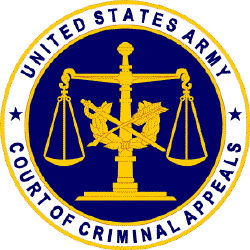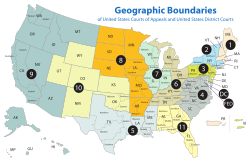
United States appellate procedure involves the rules and regulations for filing appeals in state courts and federal courts. The nature of an appeal can vary greatly depending on the type of case and the rules of the court in the jurisdiction where the case was prosecuted. There are many types of standard of review for appeals, such as de novo and abuse of discretion. However, most appeals begin when a party files a petition for review to a higher court for the purpose of overturning the lower court's decision.

Harvey v. Horan, 278 F. 3d 370 is a federal court case dealing with felons' rights of access to DNA testing. The Eastern Virginia District Court originally found that felons were entitled access to DNA testing on potentially exculpatory evidence, but this finding was later overturned by the Fourth Circuit Court of Appeals. Nevertheless, the case paved the way for the Innocence Protection Act, which ensures that convicted offenders can try to prove their innocence by requesting DNA testing on evidence in government's possession that was used in their case.
A writ of coram nobis is a legal order allowing a court to correct its original judgment upon discovery of a fundamental error that did not appear in the records of the original judgment's proceedings and that would have prevented the judgment from being pronounced. The term coram nobis is Latin for "before us" and the meaning of its full form, quae coram nobis resident, is "which [things] remain in our presence". The writ of coram nobis originated in the courts of common law in the English legal system during the sixteenth century.
Actual innocence is a special standard of review in legal cases to prove that a charged defendant did not commit the crimes that they were accused of, which is often applied by appellate courts to prevent a miscarriage of justice.
The Navy-Marine Corps Court of Criminal Appeals (NMCCA) is the intermediate appellate court for criminal convictions in the United States Navy and the Marine Corps.

In the United States military, the Army Court of Criminal Appeals (ACCA) is an appellate court that reviews certain court martial convictions of Army personnel.
In United States law, habeas corpus is a recourse challenging the reasons or conditions of a person's confinement under color of law. A petition for habeas corpus is filed with a court that has jurisdiction over the custodian, and if granted, a writ is issued directing the custodian to bring the confined person before the court for examination into those reasons or conditions. The Suspension Clause of the United States Constitution specifically included the English common law procedure in Article One, Section 9, clause 2, which demands that "The privilege of the writ of habeas corpus shall not be suspended, unless when in cases of rebellion or invasion the public safety may require it."
Lefkowitz v. Newsome, 420 U.S. 283 (1975), is a U.S. Supreme Court case which held that when state law permits a defendant to plead guilty without giving up his right to judicial review of specified constitutional issues, such as the lawfulness of a search or the voluntariness of a confession, the defendant is not prevented from pursuing those constitutional claims in a federal habeas corpus proceeding.

The Air Force Court of Criminal Appeals (AFCCA) is an independent appellate judicial body authorized by Congress and established by the Judge Advocate General of the Air Force pursuant to the exclusive authority under 10 U.S.C. § 866(a). The Court hears and decides appeals of United States Air Force court-martial convictions and appeals pendente lite. Its appellate judges are assigned to the Court by The Judge Advocate General. The Judge Advocate General instructs court-martial convening authorities to take action in accordance with the Court's decisions.
Vasquez v. Hillery, 474 U.S. 254 (1986), is a United States Supreme Court case, which held that a defendant's conviction must be reversed if members of their race were systematically excluded from the grand jury that indicted them, even if they were convicted following an otherwise fair trial.
United States v. More, 7 U.S. 159 (1805), was a United States Supreme Court case in which the Court held that it had no jurisdiction to hear appeals from criminal cases in the circuit courts by writs of error. Relying on the Exceptions Clause, More held that Congress's enumerated grants of appellate jurisdiction to the Court operated as an exercise of Congress's power to eliminate all other forms of appellate jurisdiction.

The Taney Court heard thirty criminal law cases, approximately one per year. Notable cases include Prigg v. Pennsylvania (1842), United States v. Rogers (1846), Ableman v. Booth (1858), Ex parte Vallandigham (1861), and United States v. Jackalow (1862).
In law, an appeal is the process in which cases are reviewed by a higher authority, where parties request a formal change to an official decision. Appeals function both as a process for error correction as well as a process of clarifying and interpreting law. Although appellate courts have existed for thousands of years, common law countries did not incorporate an affirmative right to appeal into their jurisprudence until the 19th century.
In law, post conviction refers to the legal process which takes place after a trial results in conviction of the defendant. After conviction, a court will proceed with sentencing the guilty party. In the American criminal justice system, once a defendant has received a guilty verdict, he or she can then challenge a conviction or sentence. This takes place through different legal actions, known as filing an appeal or a federal habeas corpus proceeding. The goal of these proceedings is exoneration, or proving a convicted person innocent. If lacking representation, the defendant may consult or hire an attorney to exercise his or her legal rights.

In some jurisdictions, a petition for review is a formal request for an appellate tribunal to review the decision of a lower court or administrative body. If a jurisdiction utilizes petitions for review, then parties seeking appellate review of their case may submit a formal petition for review to an appropriate court. In United States federal courts, the term "petition for review" is also used to describe petitions that seek review of federal agency actions.
In the most common types of habeas corpus proceedings in the United States federal courts, a certificate of appealability is a legal document that must be issued before a petitioner may appeal from a denial of the writ. The certificate may only be issued when the petitioner has made a "substantial showing of the denial of a constitutional right."
Fundamental error is a legal term provided by United States Courts to describe an error which occurs whenever a judgement violates a federal fundamental right. In United States constitutional law, fundamental rights have special significance under the U.S. Constitution. Those rights enumerated in the U.S. Constitution are recognized as "fundamental" by the U.S. Supreme Court. State courts within the United States may define fundamental error rules independently of the federal courts. State fundamental error rules may include errors which violate rights in additional to those rights guaranteed by the U.S. Constitution, but these rules may not infringe upon federal fundamental rights. Any law restricting such a right must both serve a compelling state purpose and be narrowly tailored to that compelling purpose.

Hirabayashi v. United States, 828 F.2d 591, is a case decided by the Ninth Circuit Court of Appeals and recognized for both its historical and legal significance. The case is historically significant for vacating the World War II–era convictions of Japanese American civil rights leader Gordon Hirabayashi. Those convictions were affirmed in the Supreme Court's 1943 decision Hirabayashi v. United States. The case is legally significant for establishing the standard to determine when any federal court in the Ninth Circuit may issue a writ of coram nobis.
Martinez v. Ryan, 566 U.S. 1 (2012), was a United States Supreme Court case which considered whether criminal defendants ever have a right to the effective assistance of counsel in collateral state post-conviction proceedings. The Court held that a procedural default will not bar a federal habeas court from hearing ineffective-assistance-of-trial-counsel if there was no counsel or ineffective counsel in an initial-review collateral proceeding.









